#aarne thompson uther index
Explore tagged Tumblr posts
Text

Hi there!
Welcome to There's-a-Motif-for-That, where I find and meme folktale motifs in pop culture and modern stories.
This is mostly for fun, but I do think it's cool to see how these things still show up in our current storytelling. I think it can show us some commonality/universality in human experiences and the stories we tell to express those experiences. And it gives a sense of connection to oral tradition, and the enduring/adaptive nature of these elements (though to be fair most of my connections tend to go more by just the title instead of how the motif is actually used. So sometimes it’s more of a stretch for a joke, but hey memes are folklore too).
Also it's just really hilarious the types of things included in the index, they are just so random and oddly specific sometimes, it's like is that seriously a common occurrence??
What is a motif?
I'm using Stith Thompson's Motif-Index of Folk-Literature. Which is a 6 volume (fat AF) catalogue of motifs compiled and organized by folklorist Stith Thompson in 1932–1936 and 1955–1958. As such it is a tad outdated at times, and not without it's limitations (it tends to have a Eurocentric bias). Even with 2471 pages (PAGES) of motifs, something like this could never be truly comprehensive. (Other scholars have made additional regional-specific indexes, so maybe I'll get to those someday too!)
The Index is mainly used in conjunction with the Aarne–Thompson–Uther Index (yes same Thompson) for cross-referencing tales and as an organizational tool for archives (which is what the numbers are for). But where the ATU Index compiles tale-types, self-sufficient plots recurring in stories around the world, the Motif-Index is for the individual details and narrative elements within those tales. Or as Thompson puts it:
"A motif is the smallest element in a tale having a power to persist in tradition. In order to have this power it must have something unusual and striking about it"
How to read an entry:

(source)
Tbh, activity on this blog will be pretty sporadic. Also my pop culture knowledge is limited, but if anyone else is silly enough to take a dive through 2471 pages of motifs, I’ll totally take submissions or recommendations in asks
Format: I post a screenshot of the motif and a related gif, with an image link to the full scene (if i can find it) for those who need full context (though most are pretty self-explanatory). Image descriptions will be in the alt. Sometimes I'll post a scene directly, or an image if it's from literature with the context in the image description. Some posts will be compilations for either multiple examples of a motif, or multiple motifs found in one piece of media.
For the sake of organization I’m also tagging based on the broad index categories (bold for ones I've gotten to already):
A. Mythological Motifs B. Animal Motifs C. Motifs of Tabu D. Magic E. The Dead F. Marvels G. Ogres H. Tests J. The Wise and the Foolish K. Deceptions L. Reversals of Fortune M. Ordaining the Future N. Chance and Fate P. Society Q. Rewards and Punishments R. Captives and Fugitives S. Unnatural Cruelty T. Sex U. The Nature of Life V. Religion W. Traits of Character X. Humor Z. Miscellaneous Groups of Motifs
(I've tagged them below for easy navigation, along with some other category tags)
#intro post#thompson motif index of folk literature#folklore#faqs#A. Mythological Motifs#F. Marvels#K. Deceptions#N. Chance and Fate#Q. Rewards and Punishments#R. Captives and Fugitives#S. Unnatural Cruelty#other categories:#literature#compilation#reblogs#aarne thompson uther index
0 notes
Text
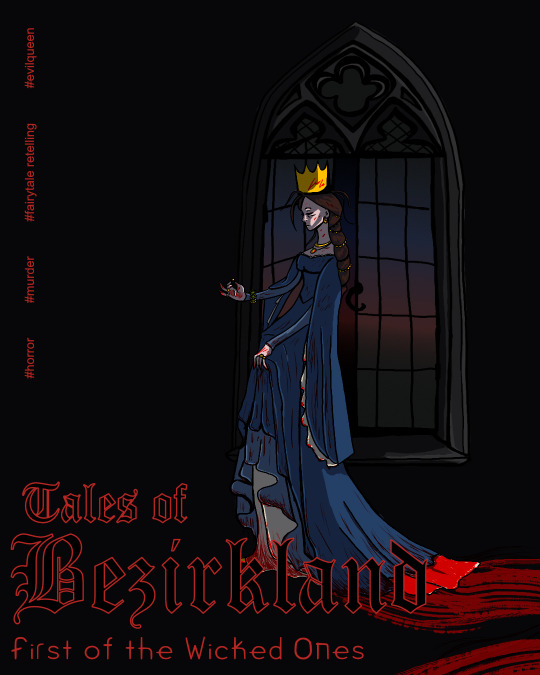
Come now and listen. I know it’s exciting. Yes, this is where I grew up. Yes, I can speak-- no, the castle is over that hill, we’ll be there by morning. I’m sure your grandmother is very excited to meet you. It’s time to sleep now, or you’ll be yawning in front of the queen. Okay, one bedtime story, but only one. What was that? Why didn’t we come sooner? Well…. What now? One question at a time dove, you’re bouncing off the walls, now sit. Those are just decorations, they have a winter holiday. No. I don’t celebrate with them. Now sit, I’ll read you a story.
Yes, I’m reading it … right now, sit. I know the road is bumpy little dove, but look at all these cushions…. Are you comfortable? Okay, I’ll begin.
They tell it different in the city, but… yes, I know that’s your favorite part, now sit still.
They tell it different in the city, but when King Wouter III toured his small land for a second wife, he plucked Pietrenella out of a butcher’s line of seven daughters, born to a world that valued them only as bodies for bartering influence, wealth, children, or labor—oh, like that’s changed. I’m sorry, I know, I know, I promised. Yes, yes, I’m reading, reading only.
After a short life spent following her own mother’s instruction in beauty, and thoroughly practiced in caring for six younger siblings, Pietrenella was beyond prepared to step into the role of… mother. Is this a fairytale or a biography? Alright, don’t get sassy.
Before she was the Nation’s Mother, that quintessential figure immortalized on every facade and coin, starved thin and dragging that heroic wheelbarrow of packed… meats and broths… meats and broths? Meats… and broths? Dragging that heroic wheelbarrow of packed meats and broths… that would save them all, she was just a butcher’s daughter, accustomed to sacrifices for the greater good.
Sigh.
No, I’m not crying. I’m… no, I’m not mad at you little dove, I’m sorry for slamming the book shut. I think… I think you might be old enough to hear a secret story. Yes, I know you don’t want me to call you little dove anymore, but you still let me read you fairytales, hm? How about I tell you a different version. I know The Great Queen Pietrenella is your favorite, but I’ve got a different one for you. Yes, different like how they tell it in the city. Are you all tucked in? Sure, I can brush your hair. You’re right, it is getting very long. Sorry, I caught a tangle, I’ll be more careful, I’m sorry dove. Do you forgive me? Oh good. Alright, I’ll start from the beginning.
They tell it different in the city, but, here’s how the ghosts tell it in the castle:
Continue reading
#grimdark#fairytales#brothers grimm#grimm fairy tales#fairy tale retelling#snow white#rapunzel#sleeping beauty#horror story#girl in the tower#aarne thompson uther index#evil queen#evil step mother#cinderella#children in the woods#short story#mommy issues#once upon a time#horror#dark fantasy#fantasy story#cw death
1 note
·
View note
Text
Another resource. Doesn’t work so well on mobile, oh well.
I think it would be fun to challenge people to write stories promoted only by categories in the aarne-thompson-uther index. With the optional additional challenge that the genre/style is NOT folk tale or fable.
Categories such as “war between birds (insects) and quadrupeds” and “which bird is father?” and “innocent slandered maiden” and “suitors at the spinning wheel” and “seemingly dead relatives” and, possibly my favorite, “cases solved in a manner worthy of Solomon”
I’m finding a lot from this table of tale types: https://libraryguides.missouri.edu/c.php?g=1083510
#reblog#addition/comment#fairy tales#folk tales#classifications#atu index#aarne thompson uther index
5 notes
·
View notes
Text
does anyone know where i can find an online version of the complete Aarne-Thompson-Uther index??
7 notes
·
View notes
Text
ATU-130
ATU-130 manifests as a group of animals. The animals seem to be of advanced age. Manifest location is usually living quarters mainly used as hideouts of illicit of organizations. After manifesting, the animals will assault the residents, driving them out, after which they claim the residence for themselves. Regardless of the previous disposition of the ex-residents, they will be too terrified to return.
If such manifestation occurs, submit the group as a new entry in the dossier of Groups Of Interest.
3 notes
·
View notes
Text
The Aaarne-Thompson-Uther Index
Animal Tales: 1 - 299
Tales in Magic: 300 - 749
Religious Tales: 750 - 849
Realisitic Tales (Set in Real Settings and Contexts): 850 - 999
Tales of the Stupid Ogre/giant/Devil: 1000 - 1199
Anecdotes & Jokes: 1200 - 1999
Formula Tales: 2000 - 2399
3 notes
·
View notes
Text
The 2024 International Discworld Convention in Birmingham was great fun, with bright new faces, familiar old faces and the sort of catch-up gossip that goes on all weekend when our last DWCon was 2018 (2020 was COVID, 2022 was My Bestie's Wedding).
There were some Not-Seen faces too, since WorldCon happening the very next weekend in Glasgow may have meant a choice of One or The Other. There'll be another DWCon in 2026, but it'll be a few years before another Worldcon is "just up the road".
Of course there were Other Reasons for missing faces, because Time isn't the only thing that passes between cons. :-(
Anyway, I took a full week off active posting - queued reblogs could take care of themselves though some of THOSE may reappear with Useful(?) Comments - and now, as has been said elsewhere:
"Well, I'm back." :->
*****
This is the Stith Thompson Index of Folklore Motifs, as I remember it from the School library more than half a century ago.

Now it's the Aarne-Thompson-Uther index, which suggests it's even bigger.
And I bet, somewhere in all those cross-referenced motifs and tropes, there's one which describes what this cat is doing.
"Helpful Animal (319.7.5) rewards Hero Kindness (247.3.3) with (a) advice; (b) encouragement; (c) warning; (d) guidance; (e) a combination of several or all, in varying sequence."
Something like that, anyway.
If I had cause to write the action in that clip, I'd be sure to mention the cat was carrying salt, not flour (Because Reasons) and that the little pause halfway to ensure a good flow wasn't done by accident.
I'm not making this stuff up, BTW: ask @dduane! :->

#caturday#Helper Animal#folktale motif index#Aarne-Thompson index#Aaren-Thompson-Uther index#Stith Thompson index
3K notes
·
View notes
Note
I figure this is the best place to ask to not get a pretentious answer (Tried googling it and the quora preview answers killed her)
The word "trope" is overused to excessive mislabeling these days, anywhere (besides TvTropes*) I can go to refresh myself on actual tropes? Scholar-y places are also okay!
*I had an obnoxious know-it-all phase IRL where I constantly referred to tv tropes in casual convos hoping someone would ask me to clarify. I'm well familiar with it. And in my defense I was in middle school.
--
Anything can be a trope. There's no set list of things that count.
You might be able to find some lists in specific contexts. In folklore studies, there's this, for example:
But really, any common motif/plot device/etc. could be discussed using this word.
38 notes
·
View notes
Text
Diamonds, Toads, and Dark Magical Girls
According to Bill Ellis in "The Fairy-Telling Craft of Princess Tutu: Meta-Commentary and the Folkloresque," the fairy tale of Cinderella can be seen as one of the earliest examples of the transformation sequences/henshin seen in magical girl anime, particularly in how the title character is given items that help her achieve a goal, usually given to her by a magical being (her mother's spirit in a tree, a fairy godmother, etc.).
Thinking again about the connection between magical girls and fairy tales--even if they aren't as meta as Tutu, many magical girls do use imagery and ideas from European fairy tales (Sailor Moon alone has references to Hans Christian Andersen and Charles Perrault)--I wondered what other character types from the genre may have some precedent in fairy tales. Then I started thinking about the Dark Magical Girl character.
Not every magical girl story has a Dark Magical Girl, but they do crop up in a lot of works. To name a few, there's Fate Testarossa from Magical Girl Lyrical Nanoha, Homura Akemi from Puella Magi Madoka Magica, Rue/Kraehe from Princess Tutu, and countless others that would be too numerous to name. In general they tend to be more cynical, darker counterparts to the main protagonists, who tend to come from relatively more stable environments. Whatever magic they possess also may be more sinister, at least initially.
Tying in somewhat to the story of Cinderella is the Aarne-Thompson-Uther Index fairy tale type "The Kind and Unkind Girls" (ATU 480). Many of the stories of this type involve a rivalry between two stepsisters, one being favored by the stepmother due to being the latter's biological daughter. The general idea in most versions of the tale is that both girls encounter a magical being at separate points in time. The kind girl helps the magical being in some way, at which point the magical being gives her a magical ability or magical presents. Meanwhile, the unkind girl refuses to help the magical being and is cursed in some fashion, or, worse, killed. The kind girl meanwhile usually ends up marrying a prince, or a similar character. One of the more popular versions of this story, "Diamonds and Toads," has the kind girl gain the ability to have a jewel or flower fall from her mouth when she speaks, while the unkind girl is cursed to have toads and snakes fall from hers. And while the kind girl does marry a prince, the unkind one is kicked out of her house and dies alone in the woods. (Insert something about Revolutionary Girl Utena's comment about how a girl who cannot become a princess is doomed to be a witch.)
Typically in these fairy tales, the unkind girl is never shown to be a real threat to the kind one; the ultimate threat is the stepmother, who uses her daughter as a means to an end. In contrast, Dark Magical Girls tend to have, well, magic that helps them attack the magical girl protagonist. In this regard, they're the Heavy in the plot, while the witch/mother-like figure/real enemy waits in the background (as is the case in a lot of magical girl shows--the Raven and Rue, Precia and Fate, Fine and Chris in Symphogear etc.). Sometimes the Dark Magical Girl will be a major threat, though--like the Princess of Disaster in Pretear (who is loosely-inspired by the Evil Queen in Snow White).
In The Uses of Enchantment: The Meaning and Importance of Fairy Tales (1976), Bruno Bettelheim argues that the stepmother as a character is a way for children to process the negative traits of their own mothers, while still idealizing the good qualities of them. With that in mind, the unkind sister and the Dark Magical Girl can be viewed as a way of processing/externalizing the negative traits that a girl can have, being cruel, rebellious, and uncaring. They also embody their fears, too--the fear of being alone, rejected, and doomed to fail.
Of course, nowadays, Dark Magical Girls have a tendency to be redeemed and reconcile with/befriend the main magical girl, something the kind and unkind girls never seem to do in the fairy tales. Maybe it's just emblematic of society deciding that killing a girl off for being a little rude is a bit unfair. She's just a kid trying to find her place in the world, too, after all.
#magical girl#magical girl lyrical nanoha#puella magi madoka magica#princess tutu#senki zesshou symphogear#dark magical girl#fate testarossa#homura akemi#rue kuroha#princess kraehe#chris yukine#cinderella#diamonds and toads#kind and unkind girls#fairy tales#hans christian andersen#brothers grimm#charles perrault#bruno bettelheim#the uses of enchantment#random thoughts#text#read more
102 notes
·
View notes
Note
how goes the reading of the andersen tales? also, thoughts on the aarne-thompson-uther index?
I am approximately 2/3rds done, I took a break last week to read something else for a book club I’m in.
I’m not knowledgable enough about fairlytales and folklore to have any strong opinions on the ATU index besides it being interesting and helping me find similar and “related” stories. I imagine there is some controversy and messiness with it as is the case with all classification systems, but I haven’t read into it enough to know about that
147 notes
·
View notes
Text
The Twelve Months/Moons, collected by Božena Němcová
According one of the Czech sources I was reading this is the oldest Czech fairy tale. In every collection I own it is the first fairy tale.
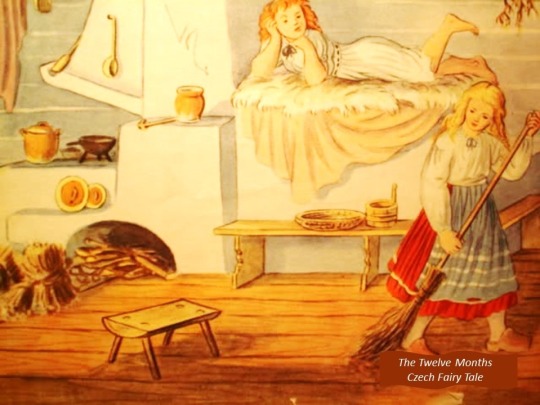
Maruška is the step-daughter of a woman who has her own daughter, Holena. Mother and daughter are jealous of Maruška’s beauty and popularity. The tale is classified in the international Aarne-Thompson-Uther Index as type ATU 480, "The Kind and Unkind Girls". Anyone who is familiar with the Brothers Grimm’s fairy tale Frau Holle (German) or Alexander Afanasyev’s Vasilisa the Beautiful (ATU 480 B, Russian, featuring our favorite witch, Baba Yaga) will recognize the theme immediately.
In each of these stories the beautiful and kind step-daughter is sent into the cold, dark woods on an impossible task by the evil step-mother.
In this case Maruška is first sent after violets in January. She encounters the personified months (moons) and impressed by her politeness as they share their fire they decide to assist her, the personification of March giving her the violets.
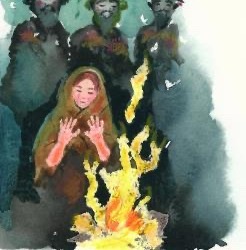


Next the evil step-mother and spoiled daughter send her for strawberries. This time when she encounters the months (moons) it is June who produces the most wonderful strawberries.
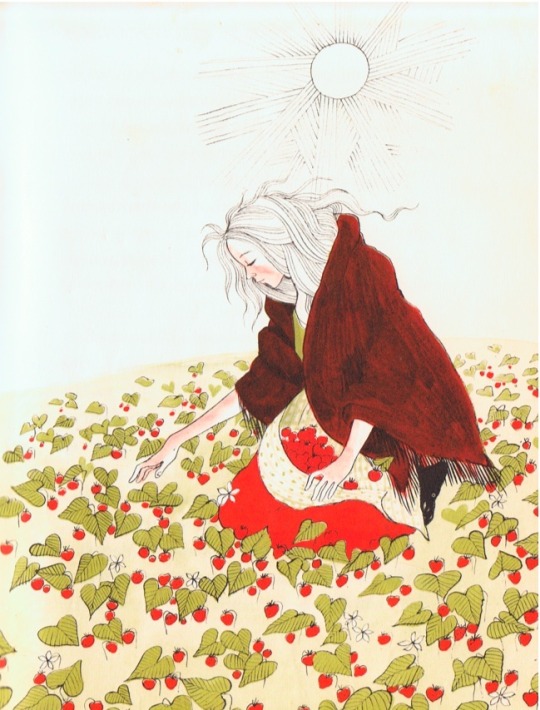

Next the evil step-mother and spoiled daughter send her for apples and it is September who provides them for her.

Eventually the greedy step-daughter goes off on her own seeking the magical fruit claiming Maruška will eat it all if she sends her. She encounters the months (moons) and when she is rude to them January makes a snowstorm and they all disappear leaving the girl to be left in the storm. When the evil step-mother goes looking for the daughter she is lost as well and Maruška inherits the farm lives happily ever after.
Here is an interesting paper that, in part, discusses the personification of days, weeks, months, holidays, etc. in various Slavic cultures.
Illustrators:
#1 unknown
#2 Darina Studentá
#3 Vera Stone
#4 Rodney Thompson
#5 T S Hyman
#6 illustrator unknown
#7 Jan Matulka
#fairy tale#folk tale#Czech#Slovak#the twelve months#Božena Němcová#marushka#Maruška#holena#atu 480#the kind and unkind girls#Darina Studentá#Vera stone#Rodney Thompson#t s hyman#Jan matulka
19 notes
·
View notes
Text
1. The Roud Folk Song Index lists it as the 39th Child Ballad. Comparisons to be made to Type 425 in the Aarne-Thompson-Uther Index, under the entry “The Search for the Lost Husband.” TvTropes.com has more to say on the page titled “Shapeshifting Lover.” A story iterated upon in many forms. A young woman, almost always a woman, sometimes virginal, is wedded, or falls in love with, or is taken away by a man under some sort of curse. He is horse. Or a lindworm. Or a wolf. Sometimes only at night. Sometimes only when the fairies who cursed him make him so. He is a Beast, she must undo whatever evil makes him so, normally through a kiss, true love, wedding him, or, in some of the less sanitized versions, simply sex. 1. The first time they hooked up he cried afterwords, which she didn’t understand at the time. They were sophomores in college. It wasn’t her first time. It should have been casual. It was up until he cried in the morning. She felt so bad that she suggested they get breakfast together, when she had simply meant to leave. At breakfast he calmed, he talked about his life. Quiet, nerdy, hiding in his hoodie. There was something vulnerable there, and she liked it. She gave him her number after. 2. Later thinkers and writers have revisited this trope. Sometimes it is played straight, depicted on the screen by Disney. Sometimes this is (falsely I would argue) called Stockholm Syndrome. Sometimes this is, it must be said, simply used for purposes of sex and titillation. I think, however, that the continued persistence of this motif in media, it’s emotional resonance, demands further explication of its longevity. What about this appeals to us in the modern day, when we (ideally) can no longer ascribe to it a moral of young women being forced to accept arranged marriages? 2. They’re a few months into their time dating, after long arguments about that label, when the crying returns. This time no longer after sex, but she feels the emotion is the same. You should leave me, he says. Break up. You should do it now before I hurt you, he says. And she, not wanting to point out that she is bigger and stronger than he is, gently asks why he says something like that? In there time together he has been nothing if not careful. Thoughtful. Kind. One of the most soft and charming people she knows. He cannot explain it in any satisfying way. He simply insists that there is something dark inside him. Something he has sought to deny far too long, and will not be able to deny forever. That if she stays she will be hurt, simply as a function of loving him. He will one day lose the fight against himself. She does not know what to do but hold him. 3. I think some of the appeal of this trope can be found in reference to another motif of our pop cultural mythos. That of the werewolf. We are used to seeing werewolves depicted from the viewpoint of the hunted. But there is perpetually the question of what such a transformation looks like from the viewpoint of the animal itself. A human transforming into a beast demands of a human audience that we consider what it must be like to monster. To be capable of hurting those we love. And yet, I at least wonder, if we are capable of hurting those loved ones, do we not still hope that they will love us as we transform? As we become different, monstrous in shape and utterly unknown even to them? 3. They graduate. Together. Move into an apartment above a Taiwanese restaurant. She gets a shitty job that has health insurance for them both. He does commission from home. It’s not perfect. There is some part of him he never shares and she does her best to make peace with that. To accept that wherever his mind goes when he is watching her put on a dress, do her make up, whatever he ponders while watching the women passing by the street outside, or after they have sex, that is something he has chosen not to share. But instead they share popcorn. And bills. And shitty inside jokes. And that time they got accidentally drunk at his mothers remarriage to Craig (fucking Craig amiright?) and got found by the staff of the hotel whose ballroom she had rented, having passed out near the punch bowl. It’s a life. It’s their life. She tries to give him space within it. 4. Consider again the Ballad of Tam Lin. The idea of Janet in the woods, holding onto her lover as wicked fairies transform him. To something ice cold. To something burning hot. To a horrible slimed thing writhing in her embrace. To a snarling wolf-monster, a beast of wicked claws and gnashing teeth. Who has, at one time or another, when circumstances reveal that which we keep hidden, felt like that? 4. She gets home unexpectedly early one spring afternoon in her late twenties. Janet from accounting somehow set fire to a microwave, which set off the sprinklers, and no one could get anything done that day. A small treat, and it validates her admittedly flash-judgment of Janet. And as she unlocks the door, flowers in hand, she finds him in front of the closet they share, and understands the secret that has been kept from her for almost a decade. 5. And then of course, the tales and legends end. Normally in the curse being lifted, the lover being returned to normal. Beast is a beast no more, the Lindworm is again a prince, Tam Lin may leave the woods a man. A simple ending to a simple story. But for us living in reality? Outside of the tidy constraints of fiction? Perhaps there is no ending. Perhaps we remain a beast, remain a wolf, remain cursed, and monstrous and strange. Perhaps we endlessly transform into new, and more twisted shapes, and have only hope that our loves will hold us nonetheless. That even if we become something that may hurt them, something they may not understand, they will still love us. 5. It is hard. It would be nice to say there are not challenges. She always thought she was bi, but the label of straight was easy, and she never had to examine it when she was with him. She keeps on stealing her dresses. There are good times too. Times where she looks at this woman still becoming, someone she had loved for a decade and still barely knows, and sees how brightly she smiles, and feels so proud. But it is above all else hard. The crying does not go away. Estrogen works wonders, but cannot stop dysphoria, and hurt, and pain. It is hard to love her. But she is trying. And when the fights over labels and new boundaries and shifting emotions break out, or the dread comes, or the weeping, she does what she can. She holds her partner, no matter the form she takes.
139 notes
·
View notes
Note
Do you think that Rey's story (excluding episode 9 'cause that was a shitshow) could be interpreted as a Cinderella/Ash girl story?
I hope you realize asking me this is like throwing chum to a shark 😈. But the short answer is yes, to a point.
The long answer is more complicated, so to begin with, let's consult the Cinderella bible:
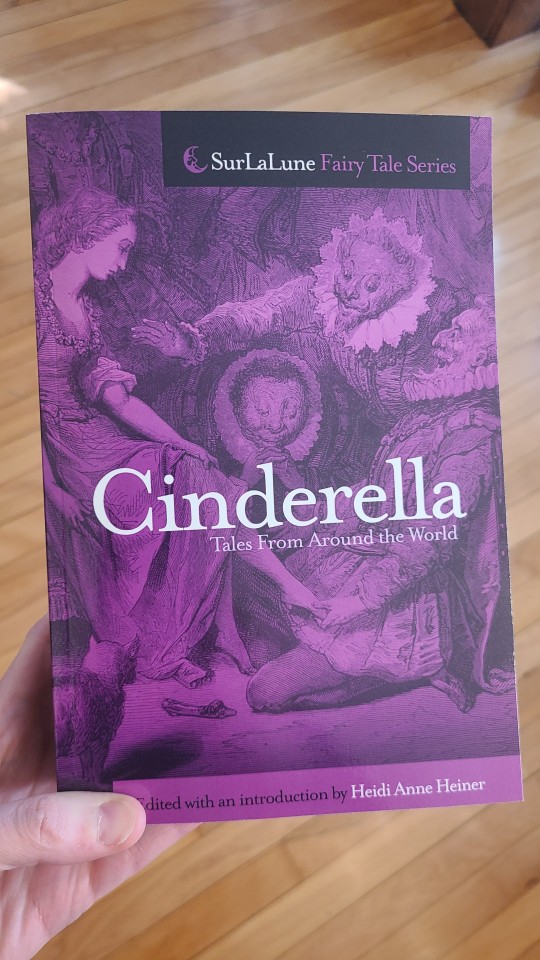
According to the Aarne Thompson Uther Index, there are five primary motifs to a Cinderella tale:
Persecuted heroine, usually by family
Help or helper, usually magic
Meeting the prince, usually with true identity disguised
Identification or penetration of disguise, usually by means of an object
Marriage to the prince
Rey is abandoned by her family, which is a form of persecution, and harassed by the inhabitants of Jakku like Unkar Plutt. Thus she clearly fulfills the first item.
As for meeting a helper, there are several for her, including Han Solo, Maz, Luke, and Leia. Any or all of these may be considered fairy godparents in the way that they offer her wisdom and material help. Further, except for Maz, they all die in the course of the story, which is consistent with many Cinderella tales in which the helper dies and their bones continue to offer wisdom and comfort to the heroine.
Next, meeting the prince. I mean
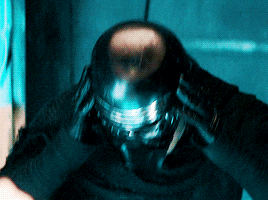
To the extent that Rey is "in disguise' here, it would be the extent of her force powers, her destiny as Ben Solo's dyad mate, and her role as the heir apparent to the Jedi (chosen by the Force to wield the legacy saber), all of which are obscured from Kylo Ren when he discovers her in the forest. Further, she is grimy and covered in desert sand, similar to how Cinderella is smeared with ashes that hide her true beauty.
So now an object penetrates the disguise. This is obviously the Skywalker lightsaber, which reveals Rey to be everything listed above, especially when she calls it to her on Starkiller Base, and again when she wields it on Ahch-to.
And lastly, marriage to the prince. As many others have pointed out over the years, Rey and Ben have almost too many symbolic marriages to count in the course of the sequel trilogy. They're extremely married, the Force said so.
BUT WAIT! Go back and look at that list again. Who ELSE fits all those criteria?

It's our boy! Consider:
He is indeed persecuted by family, most notably when Luke momentarily considers killing him.
Ben's helpers are both dark and light, as Snoke/Palpatine guide him in the dark while Luke guides him in the light (poorly). But note again what I said above about the bones of the mentor continuing to offer guidance and comfort after their death. Who should appear at Ben's lowest hour but his departed father, Han Solo? With a message of love, acceptance, and encouragement, Han's memory (because in fairy tales, bones contain memory) encourages Ben to at last cast off his beastly skin and become who he always was.
Next, meeting the prince/ss in disguise. He's wearing a literal mask when he meets Rey, so yeah.
An object penetrates the disguise? Rey slashed his face with the legacy saber, thus symbolically peeling away his mask. And I've argued before that the stabbing in TROS (which I still HATE, btw) is another cutting or burning away of the beastly skin.
And lastly, marriage to the prince/ss. As previously stated, that happened. Many times.
So yes, the Sequel Trilogy can definitely be considered a Cinderella story, with but one glaring issue: Cinderella's husband usually doesn't die at the end. But that's another topic that's been done to death, so let's all just read some more fanfic and forget about it. 👑 Thank you for the ask, this was fun!
#reylo#reylo meta#star wars#star wars meta#sw meta#star wars sequel trilogy#sequel trilogy#sequel trilogy meta#sw sequels#rey x ben#rey of jakku#ben solo#kylo ren#cinderella#aschenputtel#fairy tale#fairy tale meta#folktales#folktale types#folktale motifs#atu 510#aarne thompson uther#han solo#luke skywalker#leia organa#maz kanata#fairy godmother#my meta
103 notes
·
View notes
Text
Serpentin Vert (aka The Dragon Husband) won my fairy tale poll, so here's more about him
Serpentin Vert is both a character and the title of a fairy tale by Madame d'Aulnoy, published for the first time in 1698.
Even though the name is closer to "serpent" and some illustrators have depicted him as such, d'Aulnoy's description of him is closer to a dragon than a snake, and his size is big enough to have allowed him to physically carry his bride to safety.
Here is an English translation of the description by James Robinson Planché:
He has green wings, a body of a thousand colours, ivory claws, fiery eyes, and on his head is a bristling mane of long hair.
This is him rescuing his soon-to-be bride in an illustration from the Garnier edition, circa 1850 (my favorite one of him):
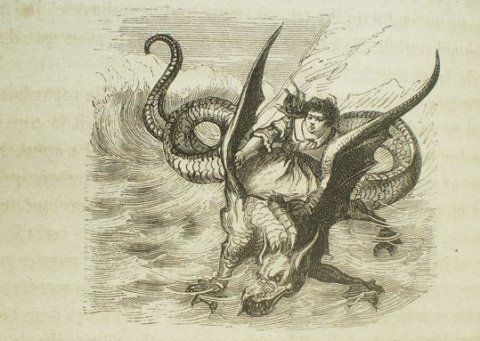
Serpentin Vert (translated by Planché as Green Serpent and in Spanish by Editorial Siruela as Serpentino Verde) is a fairy tale in the category know as "The Animal as Bridegroom" (Aarne-Thompson-Uther Index's ATU 425).
Some of these, and this one is no exception, work with Cupid and Psyche as a foundation (the most popular being Beauty and the Beast), but d'Aulnoy's style doesn't just use it as reference, she includes it in the story, as a tale the lead character reads and, much like Psyche or even Orpheus, still does what she shouldn't.
The lead of the story is Laideronnette, a princess cursed by a fairy to become the ugliest person alive, while her twin sister doesn't get said curse. She exiles herself after her family treats her poorly and meets Serpentin, who falls in love with her but she rejects him, since she's afraid of him. When he talks to her without her seeing him, she distrusts him, because she doesn't believe a king would fall in love with her, but starts having feelings for the person she spends so much time talking to. Their marriage is the halfway point of the story, because it's through Laideronnette breaking her promise (much like Psyche) that she will have to face many challenges to save the dragon she has fallen in love with. Of course, like most Animal Bridegroom stories, Serpentin is actually a cursed man.
Like most fairy tales written by the salonnières, this is a very long story, that takes twists and turns, has the characters move through different settings and gets in there a couple of songs and poems. If you're more used to the Perrault-like or even Grimm-like fairy tales, you may not be too familiar with the way in which salonnières told fairy tales, but these stories, born for the entertainment from women to other women in salons, are not always devoid of lessons but are more focused on the storytelling aspect and take a lot more pages to tell the story, describe surroundings and have the characters express their turmoil to the reader (or listener, originally).
Serpentin is always gentle and caring, although able to drop an "I told you so" when he feels it's warranted. Differently from Villeneuve's Beast (or Beaumont's even), he's more eloquent throughout the story and more active as well. There is a mutual saving between him and Laideronnette and her tasks to save Serpentin come after realizing she's in love with him, which makes their relationship dynamic a longer element to develop.
The fact that they're both cursed by the same fairy also generates an interesting dynamic in which both are at the mercy of a same enemy and can bond through the isolation caused by their self-imposed exiles. Of course, this being a classic fairy tale, she doesn't remain "ugly" and he doesn't remain a dragon.
The story isn't devoid of problematic stereotypes, these were French women in the 1600s, but most of the elements included trace back to the typical inspirations for d'Aulnoy: Greek mythology, opera and the folklore shared by midwives and nurses that accompanied women through motherhood. I talked a bit more about d'Aulnoy on this post, she was wild.
Now, to some more illustrations of the man of the hour:
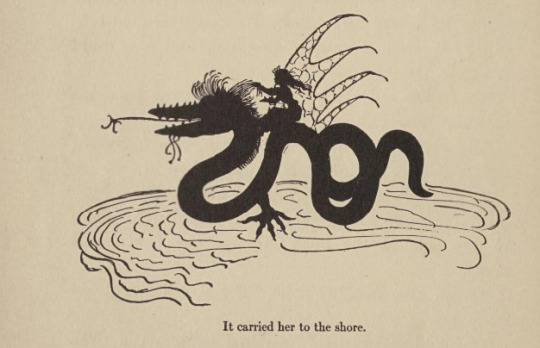
This one is from Harriet Mead Olcott (1919), who went more snake-like but kept the wings.
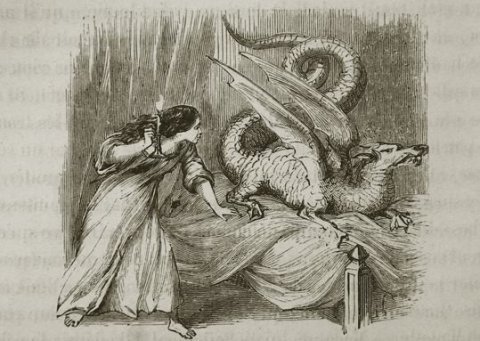
Another one from the Garnier edition, it didn't stay very consistent on the size of him.
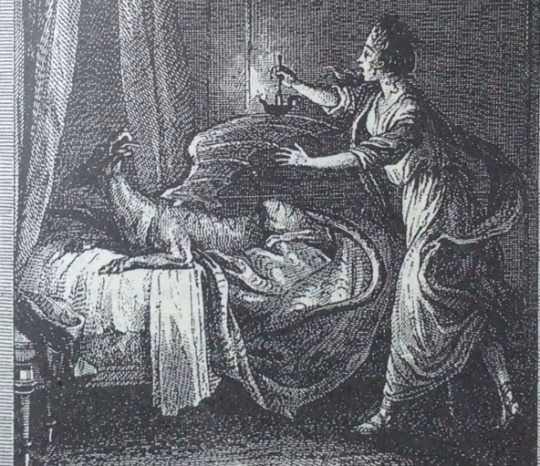
This is a part of the engraving made by Jean-Louis Delignon over this original by Clemént-Pierre Marillier (1785):
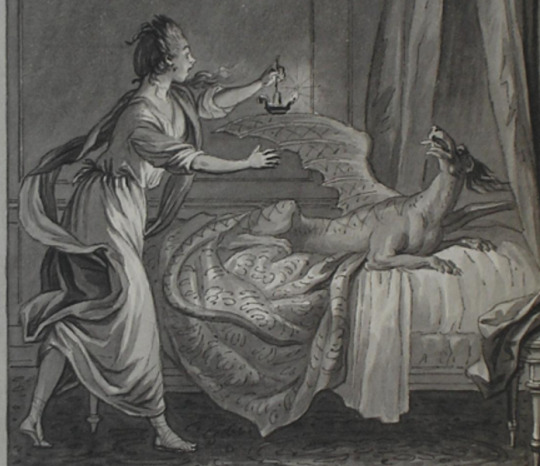
Maria Pascual played a bit more with Laideronnette's features, but it's more evident when she's beside her sister.
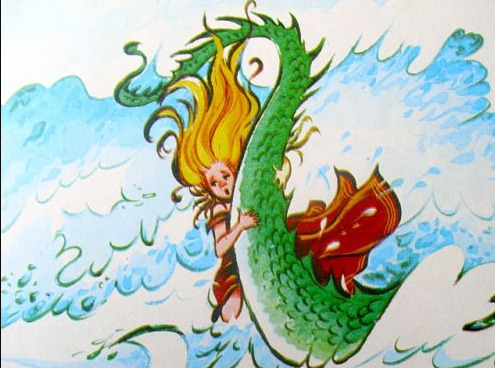
And a very recent depiction came from Natalie Frank in 2017 for Jack Zipes's compilation of d'Aulnoy stories titled The Island of Happiness, I think this is after Laideronnette was already transformed and changed her name into Discrète.

Serpentin Vert is actually the first of the fairy tales I included in my virtual workshop that starts next month (in Spanish). I suppose I shouldn't be surprised that it won the poll because of a) the nature of this site and b) the fact that d'Aulnoy would vibe with the discourse on here if she was around. You can find the original fairy tale in French here, the Planché English translation here and the Lawrence and Bullen translation here. For the Spanish version I had to translate it myself for the workshop, but there is a good translation in Siruela's edition of El cuarto de las hadas.
#fairy tales#serpentin vert#long post#luly rambles#books#I'll reblog the poll and add a link to the post in a sec so sorry for all the reblogs
86 notes
·
View notes
Text
Missed opportunity: Jack Kline 🤝Rowena -> actual longterm hunting partners
And their cases are always some variant of a fairytale. Jack quickly becomes an expert on Aarne–Thompson–Uther Index. (Jack: "Do you think I'm ATU 708 The Wonder Child?"
Do you see the vision? (BONUS: Mary, because she so embodies fairytales herself, like S240. Children unwittingly promised + and rescuing her dead husband etc. etc.)
You could throw a dart https://libraryguides.missouri.edu/c.php?g=1039894&p=7610331 and have a whole series dedicated to Rowena, Mary, Jack. I'm just saying!
I'd watch it.
Some notes:
Mary always makes a mistake and makes heroic efforts to undo it.
Jack gets turned into...something and Rowena tries to fix it but always makes it worse.
Or Rowena turns him into something as strategy and it blows up in their faces.
7 notes
·
View notes
Text
PSA: this got suuuuper long, again, like every time I want to say something about Doctor Who and end up in places I was not expecting to end up.
Wait, so you're telling me that the Master's name/nickname* is Koschei? As in, Koschei the Deathless, also known as Koschei the captive (I'm down the Wikipedia rabbit hole). Slavic folklore antihero. Koschei with his soul hidden away, where not even him can find it back. Koschei the Death God, Pale God, Winter God... Oh, this is perfect. In the Aarne-Thompson-Uther Index**, Koschei is classed under AT 302, "The Giant Without A Heart", and AT 313, " The Magic Flight"... Oh, this is fascinating.
And on the other hand, the Doctor's nickname is... Theta Sigma. As in, theta, eighth letter of the greek alphabet, and according to Urban Dictionary (more rabbit holes, yey), "the pole around which all math pivots, especially calculus" / "the brainwave of being in a dream state were u can receive messages from other dimensions" and also (man I love UD, but also you guys are turning into what-does-my-name-mean, lmao) : "Theta's most often take life seriously, are a good judge of character but befriends anyone they meet. Theta's are very deep thinkers and feelers, meaning they contemplate every aspect of life and when they love, they love deep and long. Theta's are sensitive and look for the good in others. Theta's rarely accept defeat and dig in deeper if you tell them something can't be done. The last place on earth you ever want to be is to be the one that pushed a Theta in to giving up, as this is rare and to be accomplished you have to be very cold at heart."
Like I'm not even joking, that's literally the UD definition of what a Theta person is, and damn, was the definition crafted before or after the expanded DW story where they unveiled Thete ? Because that is a bit (A LOT) on the nose. And on the other hand, sigma, 18th letter of the Greek alphabet, used and overused in practically every scientific domain, the letter/sign at the end of a word (world...), and, again according to UD, and again I'm not inventing anything: "a popular, successful, but highly independent and self-reliant person", seriously what the hell. Either the writers who decided that the Doctor and the Master should have nicknames did a splendid research job, or the people who decide what slang means (linguists? Are traditional linguists in charge of explaining new, modern slang? I feel like it but also I'm trying to imagine my old linguistic professor updating Urban Dictionary and uuh... okay, where was I) were/are hardcore Whovians.
*I'm going with the theory that Time Lords have at least three names, their real name that only spouse/partner and parents know, the one that is so complicated to pronounce "only children with their hearts in the right place can understand it", a nickname for friends during the Academy years, and the name they choose when they graduate/are adults. So in the case of our favourite unhealthy toxic duo: unknow/Koschei and Theta Sigma/The Master and The Doctor.
**The Aarne-Thompson-Uther Index, or ATU Index, is a catalogue of folktales-types, it's a useful tool when you study folklore because it allows you to see all the tales that use the same archetypes/structures. Basically you can travel all around the world and find the same stories using the same narrative elements and tools, adapted to the language/religion/geography. It is fascinating.
#the doctor#the master#the doctor and the master#doctor who#names#the importance of names#rapha talks#rapha is being a whovian#nerd ramblings
16 notes
·
View notes